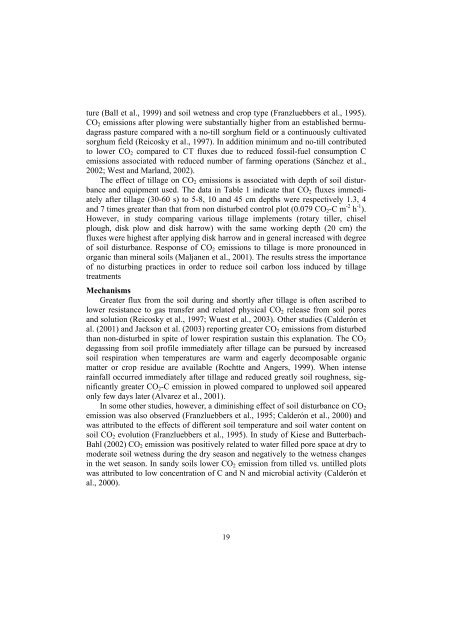soil - Lublin
soil - Lublin
soil - Lublin
Create successful ePaper yourself
Turn your PDF publications into a flip-book with our unique Google optimized e-Paper software.
ture (Ball et al., 1999) and <strong>soil</strong> wetness and crop type (Franzluebbers et al., 1995).<br />
CO 2 emissions after plowing were substantially higher from an established bermudagrass<br />
pasture compared with a no-till sorghum field or a continuously cultivated<br />
sorghum field (Reicosky et al., 1997). In addition minimum and no-till contributed<br />
to lower CO 2 compared to CT fluxes due to reduced fossil-fuel consumption C<br />
emissions associated with reduced number of farming operations (Sánchez et al.,<br />
2002; West and Marland, 2002).<br />
The effect of tillage on CO 2 emissions is associated with depth of <strong>soil</strong> disturbance<br />
and equipment used. The data in Table 1 indicate that CO 2 fluxes immediately<br />
after tillage (30-60 s) to 5-8, 10 and 45 cm depths were respectively 1.3, 4<br />
and 7 times greater than that from non disturbed control plot (0.079 CO 2 -C m -2 h -1 ).<br />
However, in study comparing various tillage implements (rotary tiller, chisel<br />
plough, disk plow and disk harrow) with the same working depth (20 cm) the<br />
fluxes were highest after applying disk harrow and in general increased with degree<br />
of <strong>soil</strong> disturbance. Response of CO 2 emissions to tillage is more pronounced in<br />
organic than mineral <strong>soil</strong>s (Maljanen et al., 2001). The results stress the importance<br />
of no disturbing practices in order to reduce <strong>soil</strong> carbon loss induced by tillage<br />
treatments<br />
Mechanisms<br />
Greater flux from the <strong>soil</strong> during and shortly after tillage is often ascribed to<br />
lower resistance to gas transfer and related physical CO 2 release from <strong>soil</strong> pores<br />
and solution (Reicosky et al., 1997; Wuest et al., 2003). Other studies (Calderón et<br />
al. (2001) and Jackson et al. (2003) reporting greater CO 2 emissions from disturbed<br />
than non-disturbed in spite of lower respiration sustain this explanation. The CO 2<br />
degassing from <strong>soil</strong> profile immediately after tillage can be pursued by increased<br />
<strong>soil</strong> respiration when temperatures are warm and eagerly decomposable organic<br />
matter or crop residue are available (Rochtte and Angers, 1999). When intense<br />
rainfall occurred immediately after tillage and reduced greatly <strong>soil</strong> roughness, significantly<br />
greater CO 2 -C emission in plowed compared to unplowed <strong>soil</strong> appeared<br />
only few days later (Alvarez et al., 2001).<br />
In some other studies, however, a diminishing effect of <strong>soil</strong> disturbance on CO 2<br />
emission was also observed (Franzluebbers et al., 1995; Calderón et al., 2000) and<br />
was attributed to the effects of different <strong>soil</strong> temperature and <strong>soil</strong> water content on<br />
<strong>soil</strong> CO 2 evolution (Franzluebbers et al., 1995). In study of Kiese and Butterbach-<br />
Bahl (2002) CO 2 emission was positively related to water filled pore space at dry to<br />
moderate <strong>soil</strong> wetness during the dry season and negatively to the wetness changes<br />
in the wet season. In sandy <strong>soil</strong>s lower CO 2 emission from tilled vs. untilled plots<br />
was attributed to low concentration of C and N and microbial activity (Calderón et<br />
al., 2000).<br />
19

















